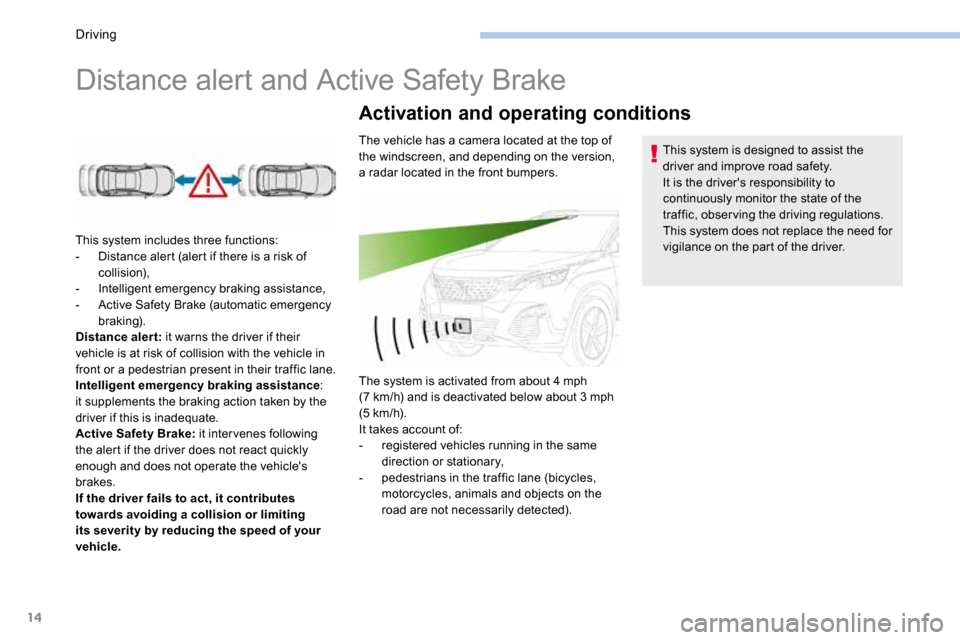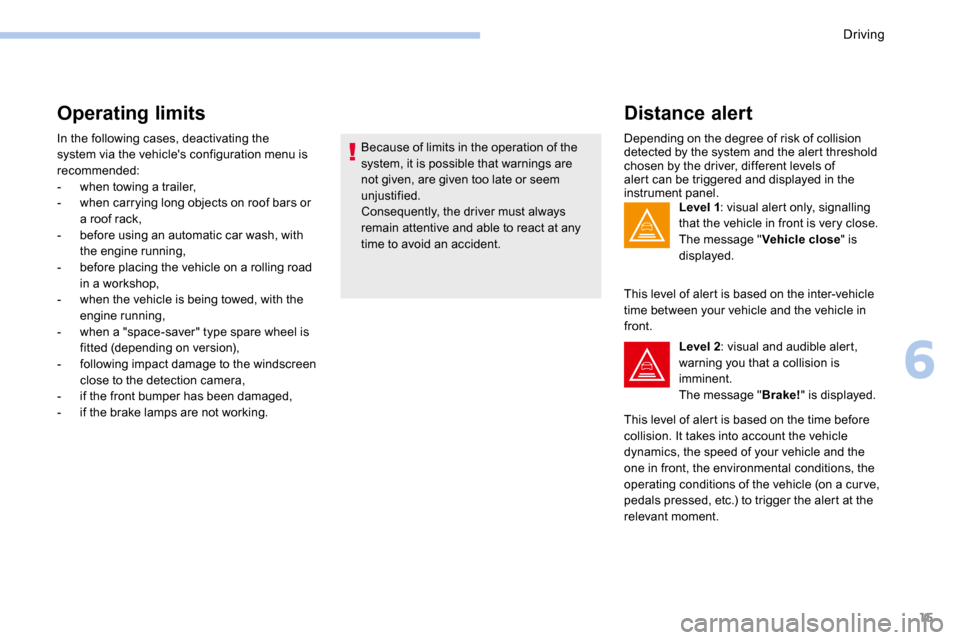Page 545 of 566

5
Precautions in use
In wintry conditions
In the event of an accumulation of snow
on the tailgate, clear the snow before
commanding a motorised opening of the
tailgate.
The formation of ice can block the tailgate
and prevent its opening: wait until the ice
melts with the heating of the passenger
compartment.When washing
When washing the vehicle in an automatic
car wash, don't forget to lock your vehicle
to avoid the risk of unexpected opening.
Recommendations related to the "Hands-Free Tailgate
Access" function
If several kicking movements to operate the
tailgate have no effect, wait a few seconds
before trying again.
The function automatically deactivates in heavy
rain or following a build-up of snow.
If it does not work, check that the electronic key
is not exposed to a source of electromagnetic
pollution (smartphone etc.).
The function may not work correctly with a
prosthetic leg.
The function may not work correctly if your
vehicle is fitted with a towbar. In some circumstances, the tailgate may open
or close by itself, particularly if:
-
you hitch or unhitch a trailer,
- you fit or remove a bicycle carrier,
- you load or unload bicycles from a bicycle
c a r r i e r,
- you place or lift something behind the
vehicle,
- an animal approaches the rear bumper,
- you are washing your vehicle,
- your vehicle is being serviced,
- you are accessing the spare wheel
(depending on version).
To avoid such operating problems, keep the
electronic key away from the sensor zone or
deactivate the "Hands-Free Tailgate Access"
function.
2
Access
Page 552 of 566
12
Windscreen wash
Wiper control stalk
F Pull the wiper control stalk towards you.
The windscreen wash and then the wiper will
operate for a fixed period.
The windscreen wash includes a wiper
blade system with integral washer jets.
The screenwash fluid is sprayed from
along the length of the wiper blade.
This improves visibility and reduces the
consumption of screenwash fluid.
In some cases, depending on the
composition or the colour of the liquid and
the outside lighting, the liquid spray may
be hardly perceptible. To avoid damaging the wiper blades, do
not operate the windscreen washer if the
windscreen washer reservoir is empty.
Only operate the windscreen washer if
there is no risk of the fluid freezing on the
windscreen and hindering visibility. Always
use windscreen washer fluid suitable for
low temperatures during the winter period.
Lighting and visibility
Page 553 of 566

13
Trailer stability assist
When towing, this system reduces the risk of the vehicle or trailer swaying.
Operation
The system is activated automatically when the
ignition is switched on.
The electronic stability programme (ESC) must
not have any faults.
Between 36 and 100 mph (60 and 160 km/h),
if the system detects swaying movements in
the trailer, it acts on the brakes to stabilise the
trailer and, if necessary, reduces engine power
to slow down the vehicle.The correction is signalled by the
flashing of the indicator lamp in the
instrument panel and activation of the
brake lights.
Operating fault
Should a fault occur with the system,
this warning lamp comes on in the
instrument panel, accompanied by
the display of a message and an
audible signal. The trailer stability assist system
offers increased safety in normal
driving conditions, provided that the
recommendations on towing a trailer are
obser ved. It must not encourage the driver
to take additional risks, such as towing
a trailer in adverse operating conditions
(overloading, failure to obser ve the trailer
nose weight, worn or under-inflated tyres,
faulty braking system, etc.) or drive at too
high a speed.
In certain cases, the swaying of the trailer
may not be detected by the ESC system,
particularly with a light trailer.
When driving on slippery or poor sur faces,
the system may not be able to prevent
sudden swaying of the trailer.
If you continue to tow a trailer, reduce your
speed and drive carefully!
Contact a PEUGEOT dealer or a qualified
workshop to have the system checked.
For information on the weights and towed
loads, refer to the "Technical data" section or
the registration certificate for your vehicle.
For advice on driving safely when Towing a
trailer , refer to the corresponding section.
5
Safety
Page 554 of 566

14
Distance alert and Active Safety Brake
This system includes three functions:
- Distance alert (alert if there is a risk of
collision),
- Intelligent emergency braking assistance,
- Active Safety Brake (automatic emergency
b r ak ing).
Distance alert: it warns the driver if their
vehicle is at risk of collision with the vehicle in
front or a pedestrian present in their traffic lane.
Intelligent emergency braking assistance :
it supplements the braking action taken by the
driver if this is inadequate.
Active Safety Brake: it intervenes following
the alert if the driver does not react quickly
enough and does not operate the vehicle's
brakes.
If the driver fails to act, it contributes
towards avoiding a collision or limiting
its severity by reducing the speed of your
vehicle.
Activation and operating conditions
The vehicle has a camera located at the top of
the windscreen, and depending on the version,
a radar located in the front bumpers.
The system is activated from about 4 mph
(7 km/h) and is deactivated below about 3 mph
(5 km/h).
It takes account of:
- registered vehicles running in the same
direction or stationary,
- pedestrians in the traffic lane (bicycles,
motorcycles, animals and objects on the
road are not necessarily detected). This system is designed to assist the
driver and improve road safety.
It is the driver's responsibility to
continuously monitor the state of the
traffic, observing the driving regulations.
This system does not replace the need for
vigilance on the part of the driver.
Driving
Page 555 of 566

15
Operating limits
In the following cases, deactivating the
system via the vehicle's configuration menu is
recommended:
- when towing a trailer,
- when carrying long objects on roof bars or
a roof rack,
- before using an automatic car wash, with
the engine running,
- before placing the vehicle on a rolling road
in a workshop,
- when the vehicle is being towed, with the
engine running,
- when a "space-saver" type spare wheel is
fitted (depending on version),
- following impact damage to the windscreen
close to the detection camera,
- if the front bumper has been damaged,
- if the brake lamps are not working. Because of limits in the operation of the
system, it is possible that warnings are
not given, are given too late or seem
unjustified.
Consequently, the driver must always
remain attentive and able to react at any
time to avoid an accident.
Distance alert
Depending on the degree of risk of collision
detected by the system and the alert threshold
chosen by the driver, different levels of
alert can be triggered and displayed in the
instrument panel.
Level 1: visual alert only, signalling
that the vehicle in front is very close.
The message " Vehicle close" is
displayed.
This level of alert is based on the inter-vehicle
time between your vehicle and the vehicle in
front. Level 2: visual and audible alert,
warning you that a collision is
imminent.
The message " Brake!" is displayed.
This level of alert is based on the time before
collision. It takes into account the vehicle
dynamics, the speed of your vehicle and the
one in front, the environmental conditions, the
operating conditions of the vehicle (on a cur ve,
pedals pressed, etc.) to trigger the alert at the
relevant moment.
6
Driving
Page 559 of 566

19
Characteristics of engines and towed loads
Engines
The engine characteristics are detailed on the
vehicle's registration certificate, and in the
sales documentation.
Weights and towed loads
When the ambient temperature is high,
leaving the engine running for 1 to
2 minutes after stopping the vehicle to
allow it to cool is recommended.
The weights and towed loads relating to your
vehicle are stated in the registration certificate,
and in the sales documentation.
These values are also shown on the
manufacturer's nameplate or label.
For more information, contact a PEUGEOT
dealer or a qualified workshop.
The GTW and towed load values indicated are
valid up to a maximum altitude of 1,000 metres.
The towed load value must be reduced by 10%
for each additional 1,000 metres of altitude.
The recommended nose weight corresponds
to the weight permitted on the towbar
(dismantlable with or without a tool).
GT W:
Gross train weight High ambient temperatures may result
in a reduction in the per formance of
the vehicle to protect the engine. If the
ambient temperature is above 37°C, limit
the towed load.
Towing with a towing vehicle which is only
slightly laden may negatively affect its
handling.
Towing a trailer increases the braking
distance.
With a towing vehicle, never exceed the
speed of 62 mph (100 km/h) (obser ve the
local legislation in force).
The maximum power corresponds to
the value type-approved on a test bed,
according to the conditions defined in
European legislation (Directive 1999/99/
EC).
For more information, contact a PEUGEOT
dealer or a qualified workshop.
9
Technical data
Page 560 of 566
20
Petrol engines and towed loads
Engines1.2 litre PureTech
13 0 S &S 1.2 litre PureTech
13 0 S &S 1.6 litre THP 150
1.6 litre THP 160 1.6 litre THP 165
S&S
Gearboxes BVM6
(Manual 6-speed) E AT 6
(Auto. 6-speed) E AT 6
(Auto. 6-speed) E AT 6
(Auto. 6-speed) E AT 6
(Auto. 6-speed)
Codes EB2DTS MCM
STT EB2DTS AT6III
STT EP6FDTM AT6III EP6FDTMD
AT6III EP6FDT AT6III
STT
Model codes
MR... M4... HNYH/C1B
HNYH/C1F -
HNYH/C1K HNYW/C1B
HNYW/C1F 5GY W/C1A
5GX V/C1A5GZ W/C1B
5G Z W/C1F
Cylinder capacity (cm³) 1,1 9 91,1 9 91,59 8 1,59 81,59 8
Max power: EU standard (kW) 969611 0 120121.4
Fuel UnleadedUnleadedUnleadedUnleadedUnleaded
Braked trailer (within the GTW limit) (kg)
on a 10% or 12% gradient 1,4 0 0 - 1,3 0 0
1, 20 06006001,550
Unbraked trailer (kg) 660670600 600 685
Recommended nose weight (kg) 8080 707080
Technical data
Page 561 of 566
21
Diesel engines and towed loads
Engines1.6 litre BlueHDi
10 0 S&S 1.6 litre BlueHDi
115 S & S 1.6 litre BlueHDi
115 S & S 1.6 litre BlueHDi
120 S&S 1.6 litre BlueHDi
120 S&S
Gearboxes BVM
(Manual 5-speed) BVM6
(Manual 6-speed) E AT 6
(Auto. 6-speed) BVM6
(Manual 6-speed) E AT 6
(Auto. 6-speed)
Codes DV6FD BE4 STTDV6FC ML6C
STT DV6FC AT6III
STT DV6FC ML6C
STT DV6FC AT6III
STT
Model codes
MC... BHYB/C2B
BHYB/C2F BHXH/C2B
BHXH/C2F BHXW/C2B
BHXW/C2F BHZH/C2B
BHZH/C2F -
BHZH/C2K BHZW/C2B
BHZW/C2F
Cylinder capacity (cm³) 1,5 6 01,5 6 01,5 6 01,5 6 01,5 6 0
Max power: EU standard (kW) 7385 8588 88
Fuel DieselDieselDieselDieselDiesel
Braked trailer (within the GTW limit) (kg)
on a 10% or 12% gradient 1,3 0 0
1,5 0 01,3 0 01,5 0 0 - 1,4 0 0 1,3 0 0
Unbraked trailer (kg) 680685695685695
Recommended nose weight (kg) 8080808080
9
Technical data